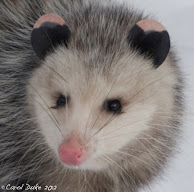The Viceroy Limenitis archippus, is a bright orange butterfly with black veins, cleverly mimicking the bad tasting and tummy aching (for the birds) milkweed butterflies. It is classified as a Mullerian mimic of the Monarch butterfly.
Therefore upon first sighting the Viceroy, an observer may believe it to be a Monarch butterfly. There are many differences, however . . . such as size and hue intensity . . . but the easiest way to identify the Viceroy, is to note the thick black vein drawn horizontally through the hind wings. The monarch, as illustrated above, does not have this trait. Also, notice the drops of white. . . the color of milkweed sap . . . are quite different in numbers and shapes.
The Viceroy may not be very tasty either but that does not keep the birds from trying to find out the hard way.
When spotting these beautiful butterflies further out in the gardens and fields, it is harder to determine the differences. One sure way to know a monarch from a viceroy . . . even faraway . . . is in the unique and graceful soaring flight of the monarch.
 |
| Viceroy butterfly on wild carrot Flower Hill Farm 2009 |
 |
| Viceroy on sedum Flower Hill Farm 2010 |
Viceroy butterflies may have up to three broods during May through September. Females lay beautifully intricate pale green eggs . . . that mimic plant galls . . . on the leaves of willows, poplars and even apple and cherry trees. The third instar caterpillar of the last brood will fastidiously fashion a leaf, of its preferred host plant, into a safely fastened silk-lined shelter and wait out the fall, winter and early spring months here in the northeast. Mother nature has protected these little critters by adorning them in the most unappealing garments . . . resembling bird poop. Come spring, when sap begins to stir and rise up through veins of crusty trees . . . reaching for extremities . . . tiny leaves begin unfurling, awaking sleeping caterpillars, who stretch and begin anew on their journey towards becoming rather dull, dark-brown and white chrysalises. The first boldly painted butterflies may emerge before many plants are flowering and find nourishment where they can . . . in pools of water, decaying flesh, excrement and even by shrewdly sipping aphid honeydew.
The sun sails a bit further north each longer winter day.
Robins fill the crabapples and reap the benefits of dried fruit.
Marching towards spring is always unpredictable here in the northeast. Soft snow began falling on the hard frozen ground Wednesday afternoon continuing throughout Thursday . . . the first day of March.
The soft bluish landscapes above were taken just at dusk on Thursday.
It is still very much winter here and all the overwintering caterpillars and chrysalises continue to dream while the farmers and gardeners long for spring.
Luckily we have thousands of butterfly photos to edit and other gardens to visit.
Friday is for flying away to Sweden to visit Katarina's Roses and Stuff.
Clicking into Katarina's and other wondrous gardens does help soften the hard cold fact of winter's continued chill.









































































































































